
Poa pratensis, commonly known as Kentucky bluegrass, smooth meadow-grass, or common meadow-grass, is a perennial species of grass native to practically all of Europe, North Asia and the mountains of Algeria and Morocco. Although the species is spread over all of the cool, humid parts of the United States, it is not native to North America. The Spanish Empire brought the seeds of Kentucky bluegrass to the New World in mixtures with other grasses. Poa pratensis forms a valuable pasture plant, characteristic of well-drained, fertile soil. It is also used for making lawns in parks and gardens and is common in cool moist climates like the Pacific Northwest, and Northeastern United States. When found on native grasslands in Canada, however, it is considered an unwelcome exotic plant, and is indicative of a disturbed and degraded landscape.

Soursop is the fruit of Annona muricata, a broadleaf, flowering, evergreen tree. The exact origin is unknown; it is native to the tropical regions of the Americas and the Caribbean and is widely propagated. It is in the same genus, Annona, as cherimoya and is in the Annonaceae family.
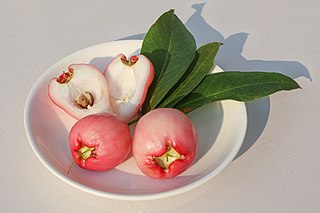
Syzygium samarangense is a species of flowering plant in the family Myrtaceae, native to an area that includes the Greater Sunda Islands, Malay Peninsula and the Andaman and Nicobar Islands, but introduced in prehistoric times to a wider area and now widely cultivated in the tropics. Common names in English include wax apple, Java apple, Semarang rose-apple and wax jambu. It is very common in the Southern Indian state of Kerala, where it is known as chambakka.

Pinus cembroides, also known as pinyon pine, Mexican pinyon, Mexican nut pine, and Mexican stone pine, is a pine in the pinyon pine group, native to western North America. It grows in areas with low levels of rainfall and its range extends southwards from Arizona, Texas and New Mexico in the United States into Mexico. It typically grows at altitudes between 1,600 and 2,400 metres. It is a small pine growing to about 20 m (66 ft) with a trunk diameter of up to 50 cm (20 in). The seeds are large and form part of the diet of the Mexican jay and Abert's squirrel. They are also collected for human consumption, being the most widely used pine nut in Mexico. This is a common pine with a wide range and the International Union for Conservation of Nature has rated its conservation status as being of "least concern".

Annona squamosa is a small, well-branched tree or shrub from the family Annonaceae that bears edible fruits called sugar-apples or sweetsops. It tolerates a tropical lowland climate better than its relatives Annona reticulata and Annona cherimola helping make it the most widely cultivated of these species. Annona squamosa is a small, semi-(or late) deciduous, much branched shrub or small tree 3 metres (9.8 ft) to 8 metres (26 ft) tall similar to soursop.

Lupinus diffusus is a species of lupine native to the southeastern United States, from North Carolina south to Florida and west to Mississippi. It is restricted to very dry, sandy soils, often in open pine or oak woodlands.

Acer tataricum, the Tatar maple or Tatarian maple, is a species of maple widespread across central and southeastern Europe and temperate Asia, from Austria and Turkey east as far as Japan and the Russian Far East. The species is named after the Tatar peoples of southern Russia; the tree's name is similarly commonly also spelled "Tartar" in English.

Bombax ceiba, like other trees of the genus Bombax, is commonly known as cotton tree. More specifically, it is sometimes known as Malabar silk-cotton tree; red silk-cotton; red cotton tree; or ambiguously as silk-cotton or kapok, both of which may also refer to Ceiba pentandra.
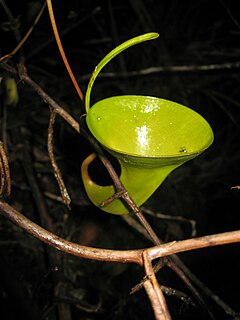
Nepenthes inermis is a tropical pitcher plant endemic to Sumatra. The specific epithet inermis is Latin for "unarmed" and refers to the upper pitchers of this species, which are unique in that they completely lack a peristome.

Bauhinia acuminata is a species of flowering shrub native to tropical southeastern Asia. Common names include dwarf white bauhinia, white orchid-tree and snowy orchid-tree. The exact native range is obscure due to extensive cultivation, but probably from Myanmar(Burma), Malaysia, Indonesia, and the Philippines.

Ulex gallii, the western gorse or dwarf furze is an evergreen shrub in the pea family (Fabaceae), native to the Atlantic coasts of western Europe: southern Scotland, England, Wales, Ireland, the Isle of Man, western France and the northern coast of Spain.

Echinocereus reichenbachii is a perennial plant and shrub in the cactus family. The species is native to the Chihuahuan Desert and parts of northern Mexico and the southern United States, where they grow at elevations up to 1,500 meters (4,900 ft). This cactus earned the Royal Horticultural Society's Award of Garden Merit.

Cassine laneana, commonly known as the Bermuda olivewood, is a species of large tree in the staff vine family, Celastraceae, that is endemic to the islands of Bermuda. Although once found in the extensive subtropical coniferous forests that covered the islands, it is currently restricted to small protected areas, such as Spittal Pond. C. laneana can grow anywhere from 25 to 40 feet tall, with leaves that are 1 to 2.5 inches long and 0.5 to 1.5 inches wide. The leaves are also a deep green colour when they are older and a bright green colour when they are younger. C. laneana flowers in late spring and early summer and produces a small ovate berry that is an olive colour and 0.25 to 0.5 inches long.
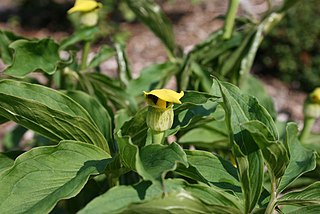
Arisaema flavum is a species of flowering plant widespread across north-eastern Africa and southern Asia. It is native to Ethiopia, Somalia, the Arabian Peninsula, Pakistan, Afghanistan, Nepal, Assam, Himalayas, Tibet, Yunnan, and Sichuan. The species epithet flavum is Latin for yellow and indicates its flower colour.

Cionura is a genus of perennial plants found through the Mediterranean regions, the South and Eastern parts of the Balkan peninsula and Asia Minor to Afghanistan. It contains only one known species, Cionura erecta.
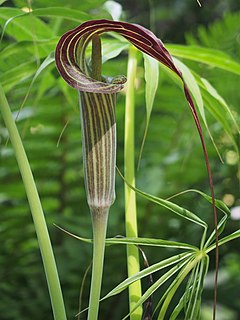
Arisaema erubescens is a flowering plant species in the genus Arisaema, endemic to Nepal.
Grevillea aurea, commonly known as the Golden grevillea or the Deaf Adder Gorge grevillea, is a shrub native to the Northern Territory in Australia.

Hakea constablei is a shrub in the Proteacea family native to eastern Australia. A bushy shrub or small tree with a profusion of white or cream flowers in spring.
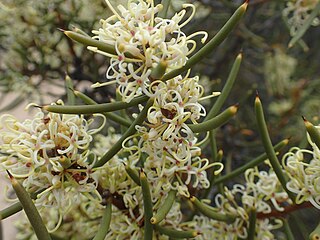
Hakea preissii, commonly known as the needle tree, needle bush and Christmas hakea, is a shrub or tree of the genus Hakea native to Western Australia. The Noongar name for the plant is Tanjinn.

Grevillea decora is a shrub of the genus Grevillea native to an area in the Great Dividing Range of Queensland.


















